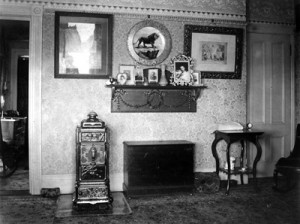A Tale from Cañon City

View a larger version of the image here
Among the decorative arts pieces on display in Mary Baker Eddy’s study at Pleasant View, her home in Concord, New Hampshire, was a large photographic print of the Royal Gorge, Colorado. Particularly striking is its depiction of the massive red rock cliffs that narrow sharply to a swift river and train track. It was a gift sent to Eddy in July of 1902 by Chalmers W. Talbot of Cañon City, Colorado.
Talbot writes:
I venture herewith to send you a remembrance of my love. If you will not go to the mountains, may with this thought of the mountains go to you? Our little City lies at the mouth of this “Grand Cañon.”1
His letter continues with a geologic description of the canyon, how an ancient sea extended up to what is the canyon’s “outer wall,” and how he broke off a specimen of “fossil fish remains,” which he also sent Eddy. He then continues:
Does not theology affirm that the fall of mankind brought death and suffering into the world? It only just occurred to me that this fossil is pretty good evidence that death—if not suffering—came into the world not less than one million of years before Adam existed.2
In her thank you letter Eddy writes:
Your glowing [description] of the scene is very acceptable for its suggestions. Here I ask did the mineral or rock specimen that you sent to me form a portion of the outlined fish or whence came your conclusion that it were a part of a fossilized fish? Pardonez Moi, but your description touched subjects greatly interesting to me, hence my enquiry.3
There is an undated single sheet of paper in the Talbot’s file of correspondence with Eddy that quotes references from James D. Dana’s 1896 4th edition of Manual of Geology on ganoids (early fish) found at Cañon City, Colorado and Joseph Le Conte’s 1891 Elements of Geology. It is unclear whether this accompanied the rock specimen or was Talbot’s response to Eddy’s question.
Talbot became interested in Christian Science when he was healed of a tobacco habit. He had class instruction in Christian Science in 1886 from Minnie B. Hall Perry of Denver, Colorado, a student of Eddy’s. He wrote an article for The Christian Science Journal in 1887 titled “The Two Accounts of the Creation.”4 In 1897 he became a member of The Mother Church, The First Church of Christ, Scientist in Boston, Massachusetts.
In February 1903 Perry writes Eddy:
Mother One of my students Mr. C. W. Talbot, Cañon City Colo. is very, very anxious that you see the Grand Cañon of our State, he sent you the picture. He says if you will accept and come he will be glad to pay all expenses for your self and party from Concord and entertain you while here. … He loves to be out among the rocks and rills – off from human thoughts this brings him more harmony with Science & Health and the Bible – as his only companions – You wrote to him a year ago.5
Eddy responds in March:
Will you say for me to Mr. C. W. Talbot I would greatly enjoy a trip to Colorado and the view that nature seems to have expanded treasures of beauty and mystery upon in the deep recesses of solitude. Tell him I deeply appreciated his proffered hospitality and end by saying – God bless him prosper and enrich him with the gifts of His love.6
The following year Talbot writes Eddy:
Your message through Mrs. Perry was beautiful. It was such a pleasure for me to know that you love the mountains as I do, (now I am trying to love them as you do)….7
In a 1903 letter from Perry to Eddy, Perry writes:
I am just in receipt of letter which tells me Mr. C. W. Talbot, to whom you wrote twice—has just “struck it rich” in his mine which he started to work on just after your letter. His hope was for success to help Mother Church Fund [for the building of the Extension] and to this cause his means will go….8

Eddy in her study with Royal Gorge print in background. P00057.
View larger version.
The print is an image of the Royal Gorge taken by well-known photographer William Henry Jackson (1843-1942), titled “Royal Gorge, Cañon of the Arkansas, Colorado.” It depicts the Arkansas River at its narrowest point in the gorge. In the background is the “hanging bridge” where the gorge is so narrow that there was no room for a rail bed. A bridge was built by suspending it from steel beams bolted into the canyon walls. The print was copyrighted in 1898 and published by the Detroit Publishing Company as No. 59002 using the photochrom process. This print hung in Eddy’s Pleasant View study and later in her Chestnut Hill home in the hall outside the library.
- C. W. Talbot to Mary Baker Eddy, 21 July 1902, IC 395.
- Ibid.
- Eddy to Talbot, 11 August 1902, L08084.
- C. W. Talbot, “The Two Accounts of the Creation,” The Christian Science Journal, June 1887, http://journal.christianscience.com/shared/view/2or0ykjdufg?s=t.
- Minnie B. Hall Perry to Eddy, 21 February 1903, IC 223a.
- Eddy to Perry, 20 March 1903, L05515.
- Talbot to Eddy, 12 November 1904, IC 395.
- Perry to Eddy, 21 February 1903, IC 223b.



